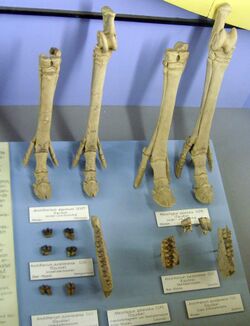Biology:Anchitherium
From HandWiki
Short description: Extinct genus of mammals
| Anchitherium | |
|---|---|

| |
| Anchitherium aurelianense, Hypohippus equinus, Merychippus sejunctus, and M. sphenodus fossils in Museum für Naturkunde, Berlin | |
| Scientific classification | |
| Domain: | Eukaryota |
| Kingdom: | Animalia |
| Phylum: | Chordata |
| Class: | Mammalia |
| Order: | Perissodactyla |
| Family: | Equidae |
| Subfamily: | †Anchitheriinae |
| Genus: | †Anchitherium von Meyer, 1844 |
| Type species | |
| Anchitherium ezquerrae | |
| Species[1][2][3][4] | |
| |
Anchitherium (meaning near beast) was a fossil horse with a three-toed hoof.

Anchitherium was a browsing (leaf eating) horse that originated in the early Miocene of North America and subsequently dispersed to Europe and Asia,[3][4] where it gave rise to the larger bodied genus Sinohippus.[1] It was around 60 centimetres (6.0 hands) high at the shoulder, and probably represented a side-branch of horse evolution that left no modern descendants.[5]
References
- ↑ 1.0 1.1 1.2 Salesa, M.J., Sánchez, I.M., and Morales, J. 2004. Presence of the Asian horse Sinohippus in the Miocene of Europe. Acta Palaeontologica Polonica, 49(2):189-196.
- ↑ Sánchez, I.M., Salesa, M.J., and Morales, J. 1998. Revisión sistemática del género Anchitherium Meyer, 1834 (Equidae; Perissodactyla) en España. Estudios Geológicos, 55(1-2):1-37
- ↑ 3.0 3.1 Ye, J.; W.-Y. Wu; J. Meng (2005). "Anchitherium (Perissodactyla, Mammalia) from the Halamagai Formation of Northern Junggar Basin, Xinjiang". Vertebrata PalAsiatica 43 (2): 100–109. http://en.cnki.com.cn/Article_en/CJFDTotal-GJZD200502001.htm.(in Chinese with English summary).
- ↑ 4.0 4.1 MacFadden, B.J. 2001. Three-toed browsing horse Anchitherium clarencei from the early Miocene (Hemingfordian) Thomas Farm, Florida. Bulletin of the Florida Museum of Natural History, 43(3):79-109.
- ↑ Palmer, D., ed (1999). The Marshall Illustrated Encyclopedia of Dinosaurs and Prehistoric Animals. London: Marshall Editions. p. 274. ISBN 1-84028-152-9.
Wikidata ☰ Q542119 entry

